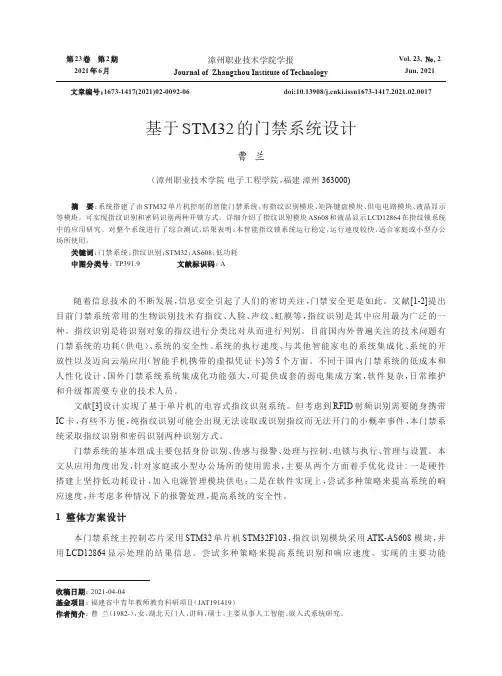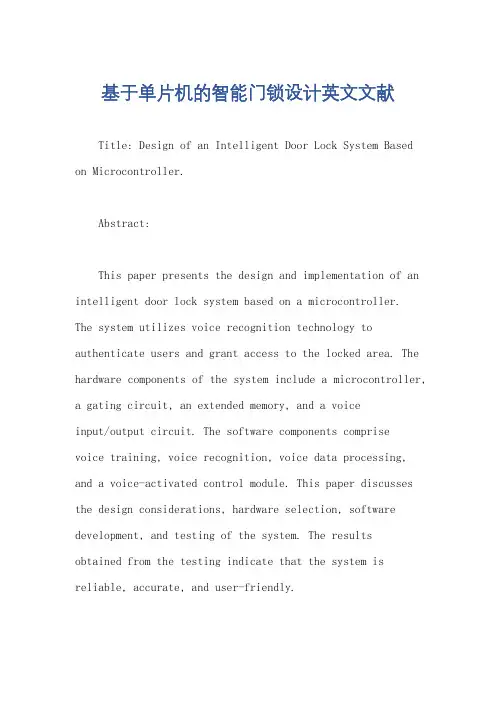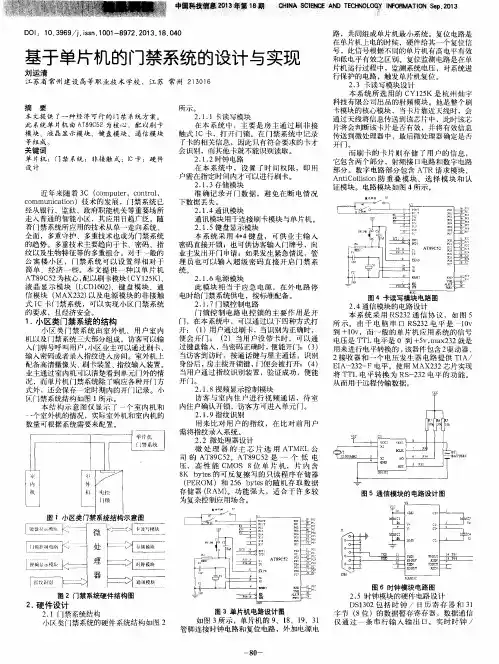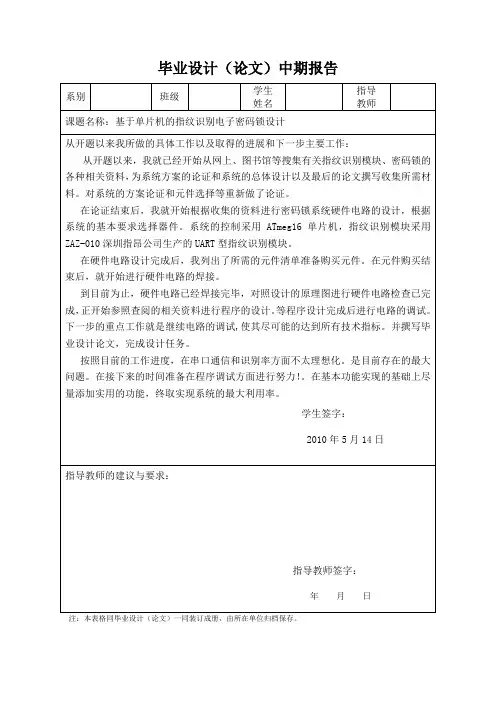基于单片机的指纹识别门禁系统设计
- 格式:doc
- 大小:1.96 MB
- 文档页数:50


题目门禁控制系统设计【摘要】本设计是利用T7122M-I工业级ID读卡模块实现的门禁控制器,具有存储一张管理卡和多张用户卡的功能,同时管理人员还可以通过按键更改管理卡,增加、删除用户卡等操作,门禁刷卡控制刷卡距离约为5—12CM。
关键词:门禁系统、T7122M-I工业级读卡模块。
目录摘要 (2)第1章门禁系统的概述 (4)1.1 门禁系统概念 (4)1.2 门禁系统的特点 (4)第2章门禁系统的设计要求 (4)2.1 设计要求 (4)第3章门禁系统的方案论证 (4)3.1门禁系统的总体方案 (4)3.2门禁系统的各个方案论证 (5)3.2.1.单片机控制芯片模块 (5)3.2.1.键盘控制块 (5)第4章门禁系统的硬件部分 (6)4.1主控芯片部分 (6)4.2键盘控制部分 (7)4.3蜂鸣器控制部分 (8)4.4T7122M-I工业读卡模块 (8)第5章门禁系统的软件部分 (9)第6章门禁系统的软、硬件调试 (12)6.1硬件调试 (12)6.2软件调试 (12)6.3软、硬件设计注意事项 (12)结论 (13)致谢 (13)参考文献 (14)附录1:系统程序。
(15)第1章门禁系统的概述1.1 门禁系统概念出入口门禁控制系统采取以感应卡来取代用钥匙开门的方式。
使用者用一张卡可以打开多把门锁, 对门锁的开启也可以有一定的时间限制。
如果卡丢失了,不必更换门锁,只需将其从控制主机中注销。
出入口门禁控制系统是通过对出入口的准入情况进行控制、管理和记录的设备,对何人何时在何地进行详细跟踪,以实现中心对出入口的24小时控制、监视及管理。
1.2 门禁系统的特点系统将ID卡技术、计算机控制技术与电子门锁有机结合,用ID卡替代钥匙,配合计算机实现智能化门禁控制和管理,有效的解决了传统门锁的使用繁琐和无法信息记录等不足,利用数据控制器采集的数据实现数字化管理可为内部人力资源的有效管理等带来意想不到的效果。
电子钥匙:授权后的ID卡即可当作电子钥匙,将此电子钥匙感应器前一晃, 控制器对该卡进行身份验证,验证合法后即控制电子门锁自动打开。

摘要摘要随着科学技术的不断提高,人们的生活水平不断提升,智能建筑将会在未来的城市建设中发挥重要的作用。
门禁系统是智能建筑领域非常重要的组成部分,不仅能够控制人员进出权限,还能够对这些人员的出入情况进行实时监控与记录,是智能建筑必不可少的安全防范设施。
射频识别门禁系统存在认证介质容易丢失、损坏, 指纹识别门禁系统容易受到环境的影响。
该设计针对目前的门禁系统研究的现状和发展的状况做了简要分析,结合对RFID 技术和指纹识别技术的研究,提出了一种基于STM32 的智能门禁系统设计方案,采用指纹识别技术和射频识别技术两种识别方式进行身份验证,完成门禁系统的多重验证方式。
避免了单一门禁系统存在的安全隐患,提高了系统的稳定性和安全性。
具体设计方案如下:硬件方面采用STM32 作为控制器,结合电源、射频识别、指纹识别、继电器等模块构建门禁系统终端的总体硬件架构。
软件方面结合硬件架构,采用模块化设计思路,设计开发主程序设计模块,指纹识别门禁模块,射频识别门禁模块。
上位机采用C#语言进行设计开发,实现门禁管理系统的设计。
在面对“互联网+”、物联网、移动智能化的挑战之下,门禁技术不断的创新,门禁系统进入了前所未有的转型期。
单一验证方式的门禁系统将被取代,智能门禁系统将成为门禁行业未来发展的趋势。
图44 幅;表13 个;参41 篇。
关键词:门禁系统;指纹识别;RFID;STM32分类号:TP399AbstractWith the continuous improvement of science and technology, and the people's living standard, intelligent building will play an important role In the future of urban construction. Door-control system is a essential key component of the field of intelligent building. It can not only control the access authority of personnel, but also monitor and record the access of these personnel in real time, which is an indispensable security and prevention facility of intelligent building. The identification medium of Radio frequency identification access control system is easily lost and damaged, and the fingerprint identification access control system is easily affected by the environment. This design makes a brief analysis of the current research status and development of the access control system and proposes a design scheme of intelligent access control system based on STM32 by combining with the RFID technology and fingerprint identification technology research. This design scheme adopts fingerprint identification technology and radio frequency identification technology to verify the identity, and completes the multiple verification of the access control system, which can avoid the hidden danger of single access control system and improve the stability and security of the system. The specific design scheme is as follows:In terms of hardware, it adopts STM32 as the controller to build the overall hardware architecture of access control system terminal by combining power supply, radio frequency identification, fingerprint identification, relay and other modules.In terms of software, it adopts modular design ideas to design and develop the main program design module, fingerprint identification access control module and RFID access control module. The upper computer adopts C# language to realize the design of access control management system.In the face of the challenge of ‘Internet plus’, internet of things and mobile intelligence, the continuous innovation of access control technology makes access control system enter an unprecedented transition period. The single verification method of access control system is gradually be replaced, and intelligent access control system will become the future development trend of the access control industry.Figure 44; Table 13; Reference 41Keywords: Access Control System,Fingerprint Recognition,RFID,STM32Chinese books catalog: TP399目次目次引言 (1)第 1 章绪论 (2)•门禁系统的概述 (2)•门禁系统的种类 (3)•门禁系统的研究现状及发展趋势 (4)•本课题研究的背景和意义 (4)•本课题研究的主要内容和结构 (6)第2 章射频识别系统原理 (8)•RFID 技术概述 (8)•RFID 系统的硬件组成 (9)•RFID 系统的软件组成 (11)•RFID 系统工作原理 (12)•电感耦合 (13)•电磁反向散射耦合 (13)•RFID 的频率标准 (14)•RFID 的应用领域 (15)•RFID 存在的问题 (16)•本章小结 (17)第3 章指纹识别技术原理 (18)•指纹识别技术概述 (18)•指纹识别原理 (19)•指纹图像的采集 (20)•指纹图像的预处理 (21)•指纹图像的特征提取 (24)•指纹图像的特征匹配 (26)•本章小结 (29)第4 章门禁系统的硬件设计 (30)•系统硬件设计方案 (30)•STM32 微控制器 (31)•MCU 主控芯片 (31)•串行外设接口(SPI) (33)•指纹识别模块设计 (36)•指纹传感器 (36)•指纹传感器模块接口 (37)•常用指令集 (38)•射频识别模块设计 (38)•MF RC522 简介 (39)•MF RC522 芯片特性 (40)•MF RC522 接口设计 (40)•天线设计 (42)4.4.5 S50 卡 (43)•系统电源电路 (44)•继电器模块 (45)•蜂鸣器提示电路 (46)•液晶显示电路 (46)•本章小结 (47)第5 章PC 机应用软件设计 (48)•Visual Studio 2010 开发环境 (48)•系统软件功能设计 (49)•系统管理软件设计 (50)•系统登录 (50)•用户信息管理 (51)•操作日志记录 (52)•用户信息查询 (52)•门锁控制界面 (52)•数据库设计 (53)•数据结构分析 (53)目次•数据表的设计 (55)•本章小结 (56)第6 章门禁系统软件设计 (57)6.1开发环境 (57)6.2主程序模块设计 (58)6.3射频模块程序设计 (59)6.4指纹模块程序设计 (63)6.5阅读器与射频卡之间的通信协议 (65)6.6本章小结 (66)结论 (67)参考文献 (68)附录A 门禁系统原理图 (71)致谢 (73)导师简介 (74)作者简介 (75)学位论文数据集 (76)引言引言生物识别技术是近几年发展起来的安全、便捷的身份认证技术,受到社会各界的高度重视。

基于单片机控制的电子密码锁设计目录摘要 (I)关键词 (I)Abstract ................................................................................................................... I I Key words ............................................................................................................... I I 1 绪论. (1)1.1 课题背景 (1)1.2 课题的目的和意义 (1)1.3 电子密码锁发展趋势 (1)1.4 本设计完成的工作 (2)2 总体方案设计 (2)2.1 电源模块 (3)2.2主控制器模块 (3)3 硬件实现及单元电路设计 (4)3.1 主控制模块 (4)3.2 单片机的时钟电路与复位电路设计 (4)3.3 单片机管脚说明 (5)3.4 键盘电路设计 (6)3.5 数码管显示电路设计 (6)3.6 存储芯片电路设计 (7)3.7 报警电路 (7)3.8 密码锁电路 (7)4 红外遥控电路设计 (8)4.1 红外通信基本原理 (8)4.2红外通信标准 (9)4.3 红外线遥控原理 (10)4.4 主要模块设计 (10)5 系统软件设计方案 (11)5.1 主程序流图 (11)5.2 开锁软件设计 (12)6 系统的安装与调试 (15)6.1硬件的安装 (15)6.2单片级密码锁的仿真 (16)结论 (16)致谢 ...................................................................................... 错误!未定义书签。
参考文献 (17)附录1 整机电路原理图 (18)附录2 部分源程序 (18)附录3:实物图 (27)基于单片机控制的电子密码锁设计摘要:本设计研究的对象是单片机密码锁,单片机密码锁由硬件和软件组成,硬件部分有电源输出电路、晶振电路、复位电路、键盘接口电路、开锁电路、报警电路、继电器、以及51单片机组成。

一种基于STM32的智能门锁系统的设计Design of an intelligent door lock system based on STM32毕业设计(论文)原创性声明本人郑重声明:所呈交的毕业设计(论文),是本人在指导老师的指导下,独立进行的设计(研究)工作及取得的成果,论文中引用他人的文献、数据、图件、资料均已明确标注出,论文中的结论和结果为本人独立完成,不包含他人已经发表或撰写的作品及成果。
对本文的研究做出贡献的个人和集体,均已在论文中作了明确的说明。
本人完全意识到本声明的法律结果由本人承担。
毕业论文作者(签字):签字日期:年月日摘要随着人们安全意识的不断提高和安全技术的发展,传统的机械锁将被智能门锁逐渐取代。
使用指纹,密码或其他方式替换钥匙,用户不再需要担心出门时忘记带上钥匙或者意外丢失了钥匙,而站在门外,或者当他们逛街回家带一个大袋子时,站在门外翻包找钥匙等情况,这为日常生活提供了很多便利。
本设计由STM32F103C8T6单片机核心电路板、生物指纹识别电路、薄膜矩阵键盘电路、RFID-RC522射频感应电路、LCD12864液晶显示电路以及蜂鸣器模块电路组成。
支持指纹、NFC、密码以及感应卡四种方式进行开锁。
通过LCD12864液晶显示屏显示系统操作界面,分别有运行界面、密码管理界面、指纹管理界面以及IC卡管理界面。
本系统具有分级管理权限,管理员才可以进行增删信息,比如修改密码、添加或者删除指纹信息以及IC卡信息等;支持虚位密码,在正确密码前后可随意输入数字,保护真实密码;多次密码或指纹开锁失败则劫持开锁,使用管理员密码即可开锁并恢复正常。
关键词:智能门锁;STM32;指纹识别;射频识别模块;虚位开锁密码AbstractWith the continuous improvement of people's safety awareness and the development of safety technology, traditional mechanical locks will be gradually replaced by intelligent door locks. Use fingerprints, passwords or other ways to replace the key, users no longer need to worry about forgetting to bring the key when they go out or accidentally losing the key, and standing outside the door, or standing outside the door when they go home shopping with a big bag for example, finding a key, this provides a lot of convenience for daily life.This design is composed of the core circuit board of STM32F103C8T6 single chip microcomputer, biological fingerprint identification circuit, film matrix keyboard circuit, RFID-RC522 radio frequency induction circuit, LCD12864 liquid crystal display circuit and buzzer module circuit. Support fingerprint, NFC, password and proximity card to unlock. The system operation interface is displayed through the LCD12864 liquid crystal display, which respectively has a running interface, a password management interface, a fingerprint management interface, and an IC card management interface. This system has hierarchical management authority, and administrators can add or delete information, such as changing passwords, adding or deleting fingerprint information and IC card information, etc. It supports virtual passwords, you can enter numbers before and after the correct password to protect the real password; multiple passwords or if the fingerprint unlocking fails, the unlocking is hijacked, and the administrator password can be used to unlock and return to normal.Keywords: smart door lock; STM32 single chip microcomputer; fingerprint identification; radio frequency identification module; virtual password目录第一章绪论 (1)1.1 课题背景及其意义 (1)1.2 国内的研究状况 (1)1.3 论文结构安排 (2)第二章整体方案设计 (3)2.1 需求分析 (3)2.2 系统整体方案 (3)2.3 系统整体框架图 (4)第三章硬件电路的设计 (5)3.1 硬件电路总体设计 (5)3.2 传感器模块电路设计 (5)3.2.1 STM32单片机核心电路设计 (5)3.2.2 ATK-AS608生物指纹识别模块 (7)3.2.3 RFID-RC522读卡模块 (9)3.2.4 LCD12864液晶显示模块 (12)3.2.5 薄膜矩阵键盘模块 (15)3.2.6 AMS1117-3.3v电源模块 (16)3.2.7 有源蜂鸣器模块 (17)第四章系统软件设计分析 (18)4.1 单片机程序开发环境 (18)4.2 ARM软件库开发流程 (18)4.3 系统软件流程图 (19)第五章系统的焊接与调试 (21)5.1 电路焊接 (21)5.2 系统调试 (21)5.2.1 系统程序调试 (22)5.2.2 系统硬件调试 (22)5.3 实物测试 (22)参考文献 (24)致谢 (25)附录 (26)第一章绪论1.1 课题背景及其意义传统锁具一直都是使用钥匙进行开锁,人们常会遇到钥匙丢失或者忘记钥匙放在哪里而找不到等各种问题。

基于51单片机的电子密码锁设计摘要:本文设计了一种基于单片机的电子密码锁,由单片机系统、矩阵键盘、LED显示和报警系统组成。
系统能完成开锁、超次锁定、报警、修改用户密码基本的密码锁的功能。
除上述基本的密码锁功能外,还具有掉电存储、声光提示等功能。
本密码锁具有安全性高、成本低、功耗低、易操作、记住密码即可开锁等优点。
关键词:STC89C52;电子密码锁;矩阵键盘1绪论1.1 课题背景随着人们生活水平的提高和安全意识的加强,对安全的要求也就越来越高。
锁自古以来就是把守护门的铁将军,人们对它要求甚高,既要安全可靠的防盗,又要使用方便,这也是制锁者长期以来研制的主题。
随着电子技术的发展,各类电子产品应运而生,电子密码锁就是其中之一。
据有关资料介绍,电子密码锁的研究从20世纪30年代就开始了,在一些特殊场所早就有所应用。
这种锁是通过键盘输入一组密码完成开锁过程。
研究这种锁的初衷,就是为提高锁的安全性。
由于电子锁的密钥量(密码量)极大,可以与机械锁配合使用,并且可以避免因钥匙被仿制而留下安全隐患。
电子锁只需记住一组密码,无需携带金属钥匙,免除了人们携带金属钥匙的烦恼,而被越来越多的人所欣赏。
电子锁的种类繁多,例如数码锁,指纹锁,磁卡锁,IC卡锁,生物锁等。
但较实用的还是按键式电子密码锁。
1.2 课题设计目标本设计采用STC89C52单片机为主控芯片,通过软件程序组成电子密码锁系统,能够实现:(1) 密码输入错误,蜂鸣器报警。
(2) 密码为6位,可以随意更改,(3) 采用矩阵按键输入。
(4) 通过LCD1602液晶显示。
(5) 有开锁指示灯。
(6)查阅有关文献与资料,深入学习单片机硬件原理图及软件编程相关知识。
2系统方案论证系统将从主控部分和密码输入方式两方面进行论证。
2.1 主控部分的选择方案一:采用数字电路控制用以74LS112双JK触发器构成的数字逻辑电路作为密码锁的核心控制,共设了9个用户输入键,其中只有4个是有效的密码按键,其它的都是干扰按键,若按下干扰键,键盘输入电路自动清零,原先输入的密码无效,需要重新输入;如果用户输入密码的时间超过10秒(一般情况下,用户不会超过10秒,若用户觉得不便,还可以修改)电路将报警20秒,若电路连续报警三次,电路将锁定键盘2分钟,防止他人的非法操作。

基于单片机的智能门锁设计英文文献Title: Design of an Intelligent Door Lock System Based on Microcontroller.Abstract:This paper presents the design and implementation of an intelligent door lock system based on a microcontroller.The system utilizes voice recognition technology to authenticate users and grant access to the locked area. The hardware components of the system include a microcontroller, a gating circuit, an extended memory, and a voiceinput/output circuit. The software components comprisevoice training, voice recognition, voice data processing, and a voice-activated control module. This paper discusses the design considerations, hardware selection, software development, and testing of the system. The resultsobtained from the testing indicate that the system is reliable, accurate, and user-friendly.Keywords: Microcontroller, Intelligent Door Lock, Voice Recognition, Hardware Design, Software Development.I. Introduction.With the increasing demand for security and convenience in modern homes and offices, intelligent door lock systems have become a popular choice. These systems combine the traditional locking mechanism with advanced technologies such as voice recognition, fingerprint scanning, or facial recognition to provide secure and convenient access control. This paper focuses on the design and implementation of an intelligent door lock system based on a microcontroller and voice recognition technology.II. System Design.The intelligent door lock system is designed to authenticate users based on their voices and grant accessto the locked area. The system consists of hardware and software components. The hardware components include a microcontroller, a gating circuit, an extended memory, anda voice input/output circuit. The software components comprise voice training, voice recognition, voice data processing, and a voice-activated control module.The microcontroller serves as the brain of the system, controlling and coordinating all other components. It receives voice input from the user, processes it through the voice recognition module, and compares it with the pre-stored voice templates stored in the extended memory. If the match is successful, the gating circuit is activated, unlocking the door.III. Hardware Selection.In this system, the microcontroller plays a crucial role. We have chosen the SPCE061A single-chip microcontroller due to its excellent performance, low cost, and ease of programming. The gating circuit is designed to control the locking mechanism of the door. The SPR4096 extended memory is used to store the voice templates and other important data. The voice input/output circuit is responsible for capturing the user's voice and generatingthe necessary audio output.IV. Software Development.The software development process involves writing code for the voice training module, voice recognition module, voice data processing module, and voice-activated control module. The voice training module allows users to record their voices and create voice templates. The voice recognition module compares the user's voice input with the pre-stored voice templates and determines whether the match is successful. The voice data processing module handles the preprocessing and feature extraction of the voice signal. The voice-activated control module controls the gating circuit and unlocks the door if the voice recognition is successful.V. Testing and Evaluation.To evaluate the performance of the intelligent door lock system, we conducted rigorous testing. The testing included testing the accuracy of voice recognition, theresponse time of the system, and the durability of the hardware components. The results obtained from the testing indicate that the system is reliable, accurate, and user-friendly.VI. Conclusion.This paper presents the design and implementation of an intelligent door lock system based on a microcontroller and voice recognition technology. The system provides a secure and convenient access control mechanism for modern homes and offices. The hardware components include a microcontroller, a gating circuit, an extended memory, and a voice input/output circuit. The software components comprise voice training, voice recognition, voice data processing, and a voice-activated control module. The testing conducted on the system demonstrates itsreliability, accuracy, and user-friendliness. Future work includes enhancing the system's performance, integrating additional security features, and exploring other biometric technologies for authentication.。

本科毕业设计(论文)题目基于单片机的电子密码锁设计院(系部)河北大学专业名称电子信息工程年级班级学生姓名指导教师2011年月日摘要本课题设计了一种基于单片机的数字电子密码锁,这种数字电子密码锁以单片机作为数据处理主控芯片。
电子密码锁的设计主要由四部分组成:4×4矩阵键盘接口电路、以AT89S52芯片为核心的密码锁的数据处理及控制电路、掉电情况下依然能保存密码的EEPROM存储器芯片,输出七段显示电路。
另外系统还有LED提示灯,报警蜂鸣器,单片机复位电路等。
电子密码锁设计的关键问题是实现密码的输入、清除、开锁、更改等功能。
同时该密码锁具有设计方法合理,简单易行,成本低,安全实用等特点,符合住宅,办公室等场所的用锁要求,具有推广价值。
关键词单片机密码锁 4*4矩阵键盘 EEPROM存储芯片实用经济AbstractThis project designed a digital electronic lock which used a MCU as data process and control chip. The main functions digital electronic lock are as follows:The design of the electronic password lock is mainly made up of four parts: 4×4 matrix keyboard interface circuit, data processing and control circuit, eeprom memory chip that is used to keep password when the lock loses power and display circuit. In addition the system also consists of LED lights, alarm buzzers, single-chip reset circuit and so on..The key question of the electronic lock designing is the realization of functions, such as the input password, clear password, unlock, change password and other functions.And the designed cipher lock is characterized by its reasonable designing methods, simple operation, low cost and property of safety and practicality.Besides,it works well as a residence lock and has great potential for commercial development.Key words: SCM Cipher lock 4*4matrix keyboard EEPROM Practical economy目录1 绪论 (1)1.1国内外研究综述 (1)1.2选题的目的和意义 (2)1.3本论文的任务 (3)2电子密码锁总体设计 (4)2.1系统总体设计 (4)2.2单片机 (5)2.3密码存储芯片选择 (10)2.4键盘输入方案比较 (12)2.5显示方案比较 (13)3电子密码锁的硬件设计 (1)3.1系统结构框图 (1)3.2主控部分 (2)3.3显示部分 (3)3.4键盘输入部分 (4)3.5密码存储部分 (5)3.6电源部分 (5)3.7其它功能部分 (8)3.8 电子密码锁的电路原理图 (10)4电子密码锁的软件组成 (12)4.1系统软件设计流程 (12)4.2 Keil uVision2软件介绍 (13)4.3各主要部分的功能实现程序设计 (14)4.3.1初始化程序设计 (14)4.3.2按键处理程序设计 (17)4.3.3密码更改程序设计 (21)5系统仿真 (24)5.1系统仿真过程 (24)5.2仿真调试中遇到的问题及解决办法 (25)总结 (1)致谢 (2)参考文献 (3)附录 (4)1 绪论1.1国内外研究综述在电子锁出现以前人们广泛的使用机械锁,但是随着时间的推移机械锁已不能满足人们的要求,于是电子锁应用而生。

基于51单片机的指纹密码锁设计与制作作者:陈新芬邱小华金琦淳来源:《无线互联科技》2024年第05期摘要:文章以单片机STC89C52作为指纹密码锁的控制核心,通过4×4矩阵键盘实现按键输入,实现普通密码解锁以及指纹解锁2种解锁方式。
在开机初始界面,矩阵键盘输入数字密码则实现普通密码开锁功能,如果按压AS608指纹模块,则实现指纹解锁功能。
LCD12864液晶显示屏实时显示密码锁的当前状态。
矩阵键盘输入实现人性化按键功能:密码输入实时加密显示输入位数,如果输入出错,则可以实现退格或者返回初始界面功能。
密码锁在管理员界面,可以实现录入指纹、删除指纹以及修改开锁密码功能。
设计采用AT24C02存储芯片,实现开锁密码的稳定存储功能,利用AS608集成指纹处理模块,实现指纹模板的存储功能。
关键词:指纹密码锁;单片机STC89C52;液晶LCD12864;AS608指纹模块中图分类号:TP368.1;TP277文献标志码:A0 引言随着科学技术的发展,安全、高效、便捷的指纹密码锁已经在市场上逐渐普及。
设计中,以STC89C52单片机为控制核心的密码锁能实现友好的人机交互,实现密码开锁和指纹开锁2种功能。
指纹密码锁合理利用人类指纹个体差异,采用新型安全可靠的指纹识别技术,实现指纹开锁的同时,外加丰富的辅助功能,实现更加安全智能化开锁[1]。
1 设计功能描述开机待机状态:按下电源键,电源指示灯点亮,液晶屏待机初始界面显示“指纹密码锁”“编号”“状态”3行字样,密码锁处于待机等待开锁状态。
待机状态时,单片机主机循环扫描按键,达到实时检测按键动作的目的。
密码开锁功能:在密码锁处于待机状态时,用户输入6位开锁密码数字,液晶屏同步加密显示“*”,按下键盘上的“确认”键,密码输入结束。
密码正确,则电磁锁得电,锁头打开。
开锁的同时,系统启动内部定时器进入倒计时定时,达到定时时长,电磁锁自动断电上锁。
输入密码错误,液晶屏提示“密碼错误”字样,蜂鸣器报警器发出“滴滴滴”报警3次,锁头保持关锁状态。


基于单片机的电子密码锁设计
电子密码锁是一种常用的智能锁具,它使用数字密码代替传统的钥匙,能够提供更高的安全性和方便性。
基于单片机的电子密码锁能够实现简单的密码输入、校验和控制逻辑,下面是一种基于单片机的电子密码锁设计方案。
硬件部分:
1、MCU:选择一款高性价比的8位单片机,如AT89C51,具备足够的存储空间、操作速度和通用IO口。
2、键盘:选用16键或12键矩阵键盘,提供数字、字母和功能键,可灵活设置密码。
3、数码管:用于显示输入密码和状态信息,一般采用4位共阳数码管。
4、电路保护:此处需添加过流保护、短路保护、反向保护以及过压保护等电路。
5、电源:选择电池供电模式,例如4节AA碱性电池并联,以保证足够的电量和使用寿命。
软件部分:
1、键盘输入检测:通过IO口扫描矩阵键盘输入状态,检测按下的键位并读取对应键值,避免误触。
2、密码存储:将设定好的开锁密码存储在MCU内部的Flash或EEPROM中,以保证密码安全并避免意外丢失。
3、密码校验:将输入的数字密码与存储的密码进行比较,如一致则允许开锁,否则拒绝开锁并显示“密码错误”。
4、状态显示:通过4位共阳数码管显示输入密码、开锁状态、警报状态等信息,方便用户操作。
5、警报功能:若输入错误密码超过规定次数,则触发警报,并向指定手机号或邮箱发送警报信息。
总之,基于单片机的电子密码锁设计需要合理安排硬件和软件功能,充分保证安全性和可靠性,并考虑升级和扩展的可能性。
科学技术创新2021.13基于单片机的IC 卡门禁系统设计冯美艳殷鹏(安阳学院航空工程学院,河南安阳455000)1概述传统门锁在钥匙丢失或忘记携带时,只能从窗户进入或者采取破坏门锁的办法开锁。
传统门锁在配置时需要找专业人士,比较麻烦而且不能保证所配钥匙的准确性。
在出租房屋业务中,由于经常换租客,传统门锁因为可以随意复制,安全系数低。
针对这些问题提出了一种基于单片机的IC 卡门禁系统[2]。
IC 卡门禁系统可以通过刷卡和输入密码两种方式开锁也可以随意更改密码,可以有效解决以上问题。
2IC 卡门禁系统设计方案IC 卡门禁系统设计方案如图1系统设计方案图所示。
图1系统设计方案图该系统由单片机核心模块、RFID 读卡模块、LCD 显示模块、电源模块、报警模块、电子门锁模块和存储模块七部分组成[3]。
系统的工作模式有设置模式和正常模式两种。
系统上电后,按键模块若有设置按键按下,则系统进入设置模式。
设置模式又分为更新密码和注册IC 卡两种模式。
设置模式完成以后,将信息存入存储模块[4]。
系统上电后,若按键模块设置按键没有按下,则系统进入正常模式。
若有IC 卡靠近,RFID 读卡模块读取IC 卡中的ID 并且通过串口发送至STC89C52单片机模块。
STC89C52单片机模块接受IC 卡中的ID 并且与FLASH 中存储的ID 进行比对,比对成功则开锁并提示门已打开,开锁指示灯亮,反之则不开锁并示警。
若有按键按下密码,则按键模块通过串口将密码发送到单片机模块,单片机模块接受到密码信息并且与FLASH 中存储的密码进行比对,比对成功则开锁并提示开锁成功,开锁指示灯亮,反之则不开锁并示警[5]。
3IC 卡门禁系统软件设计IC 卡门禁系统主要由KEIL 软件设计。
系统分为设置模式和正常模式两种。
程序启动,单片机扫描设置按键是否按下,若按下则进入设置模式,确定是注册IC 卡信息还是更换密码。
并在注册IC 卡信息或更换密码后将新的IC 卡信息或密码保存在FLASH 。
基于STM-32指纹识别密码锁控制系统的设计与实现毕业论文本科生毕业论文(设计)此处为论文中文题目,要求居中填写主标题不超过24题目:基于STM-32指纹密码锁控制系统的设计与实现个汉字;可加副标题 (副标题前加破折号),副标题与主标题间空一行的位置主标题:黑体,小二,居中副标题:楷体 _GB2312,四号,居中阅后删除此文本框。
基于STM-32指纹密码锁控制系统的设计与实现摘要:本文首先介绍了指纹密码锁控制系统的开发背景和意义~简单介绍了一些国内外常见的指纹识别装置和指纹识别密码锁~并指出了当前指纹识别控制系统存在的问题~再根据完整的指纹识别模块指令确定了本系统的目标和要求~以战舰STM-32为开发平台进行了系统的总体结构设计~阐述了系统的软、硬件组成~并重点探讨了指纹识别模块、键盘模块、LCD液晶显示模块和报警模块等几个主要功能模块的设计与实现。
最后~对系统的设计与实现做相应总结。
关键词:指纹识别,战舰 STM32,模式识别Design and Implementation of STM32-based fingerprint combinationlock control SystemAbstract: This paper introduces the fingerprint lock control system development background and significance simply, introduced some common fingerprint identification device and fingerprint identification combination lock at home and abroad, and points out the problemsexisting in the current fingerprint identification control system, according to the complete fingerprint identification module instruction to determine the objectives and requirements of this system, the warship STM - 32 as a development platform for the overall structure of the system design, this paper expounds the hardware and software of the system, and probes into the input fingerprint identification module, keyboard module, LCD liquid crystal display module and alarm module, etc. Several main function module design and implementation. Finally, summarizes the design and implementation of the system.Key words: Fingerprint identification; Warship STM32; Pattern recognitionI目录1绪论 (1)1.1 开发背景和意义 ......................................................1 1.2 国内外研究现状 ...................................................... 1 1.2.1 总体研究现状 .................................................... 1 1.2.2 指纹采集技术的研究现状 .......................................... 2 1.2.3指纹识别技术的研究现状 ........................................... 3 1.3本文主要研究内容和章节安排 (3)2系统总体结构设计 ........................................................ 4 2.1 系统设计总体要求 . (4)2.2硬件总体结构设计 .................................................... 4 2.3软件总体结构设计 (5)3系统硬件模块设计与实现 .................................................. 63.1指纹识别模块设计与实现 .............................................. 6 3.2 LCD液晶显示模块设计与实现 ........................................... 7 3.3键盘模块设计与实现 (8)3.4报警模块设计与实现 ..................................................9 4系统软件模块设计与实现 ................................................. 10 4.1键盘模块程序设计与实现 ............................................. 10 4.2报警模块程序设计与实现 ............................................. 10 4.3 LCD液晶显示模块程序设计与实现 ...................................... 11 4.4指纹识别模块程序设计与实现 .. (12)4.4.2指纹识别模式 ....................................................12 4.4.2指纹识别模式 .................................................... 13 5系统实现结果 ........................................................... 14 5.1系统总体框架 . (14)5.2指纹录入模式 .......................................................15 5.3指纹识别模式 (17)II5.4结果分析 ........................................................... 19 6总结与展望 . (19)参考文献 (20)致谢 .....................................................................21III1绪论1.1 开发背景和意义指纹就是我们人类手指末端指腹上由凹凸的皮肤所形成的纹路,是人类在进[1]化过程中自然形成的。
基于STM32自动门禁控制系统设计自动门禁控制系统在现代社会中得到了广泛的应用,它不仅提高了安全性,还提供了便利性和舒适性。
STM32芯片作为一种高性能的嵌入式微控制器,具有强大的处理能力和丰富的外设接口,成为设计自动门禁控制系统的理想选择。
本文将从硬件设计、软件开发、安全性以及未来发展趋势等方面介绍基于STM32的自动门禁控制系统设计。
一、硬件设计1.1 系统架构基于STM32芯片的自动门禁控制系统主要由硬件和软件两部分组成。
硬件部分包括传感器模块、执行器模块、通信模块以及电源管理模块等。
传感器模块用于感知周围环境,如人体红外传感器用于检测人体活动;执行器模块用于控制门体开关;通信模块用于与外部设备进行数据交互;电源管理模块提供稳定可靠的电源供应。
1.2 传感器选择在自动门禁控制系统中,人体红外传感器是必不可少的传感器之一。
它能够感知人体的热量,并将信号传递给控制器。
此外,还可以选择其他传感器,如声音传感器、光线传感器等,以实现更多功能。
1.3 执行器选择自动门禁控制系统的执行器主要用于门体的开关控制。
常见的执行器有电机、电磁阀等。
在选择执行器时,需要考虑门体的大小、重量以及开关速度等因素。
1.4 通信模块选择通信模块用于实现自动门禁控制系统与外部设备之间的数据交互。
常见的通信模块有蓝牙、Wi-Fi、以太网等。
根据实际需求选择合适的通信模块,并考虑其稳定性和兼容性。
1.5 电源管理自动门禁控制系统需要稳定可靠的电源供应,因此需要设计合适的电源管理模块。
可以使用稳压芯片和滤波电容等元件来满足系统对电源供应稳定性和可靠性的要求。
二、软件开发2.1 系统架构设计在软件开发阶段,首先需要进行系统架构设计。
根据硬件设计确定硬件接口和功能需求,将系统划分为不同的模块,确定模块之间的通信方式和数据交互方式。
2.2 软件开发环境选择STM32芯片支持多种开发环境,如Keil、IAR等。
根据实际需求选择合适的开发环境,并进行相应的配置。
(完整版)指纹识别模块单片机程序#include#include#define TRUE 1unsigned char SaveNumber=0,searchnum=0;unsigned int S earchNumber=0;unsigned int clk0=0;sbit relay =P1^4; //继电器引脚sbit buzzer=P1^5; //蜂鸣器引脚sbit red= P2^7;//录入模式指示灯在板子靠近单片机处sbit green= P2^0;//识别模式指示灯在板子远离单片机处sbit k1=P3^3; //模式识别sbit k2=P3^4; //录入一次指纹sbit k3=P3^2; //清除所有指纹(10个指纹清除)//变量定义:unsigned char code tab[10]={0xc0,0xf9,0xa4,0xb0,0x99,0x92,0x82,0xf8,0x80,0x90};//表:共阳数码管0-9//数码管引脚定义:sbit SMG_g = P1^3; //定义数码管阳级控制脚(个位)//由于程序中定时器被用我们用一位数码管显示且为静太显示所以推荐大家用1602或者12864液晶bit changeflag=0,modeflag=0,clearallflag=0; //默认为识别模式,如果为1为录入指纹模式,每录入一次SaveNumber++ //////////////////////////////////////常用指令定义///////////////////////////////Verify Password :验证设备握手口令unsigned char code VPWD[16]={16,0X01 ,0Xff,0xff,0xff,0xff, 0x01,0,7,0x13,0x00,0x00,0x00,0x00,0x00,0x1b}; //回送12个//设置设备握手口令unsigned char code STWD[16]={16,0X01 ,0Xff,0xff,0xff,0xff, 0x01,0,7,0x12,0x00,0x00,0x00,0x00,0x00,0x1a}; //回送12个//GetImage :探测手指并从传感器上读入图像unsigned char code GIMG[14]={12, 0X01 ,0Xff,0xff,0xff,0xff, 0x01, 0,3,1,0x00,0x05}; //回送12个//Gen Templet1 :根据原始图像生成指纹特征1unsigned char code GENT1[14]={13,0X01 ,0Xff,0xff,0xff,0xff,0x01,0,4,2,1,0x00,0x08}; //回送12个//Gen Templet2 :根据原始图像生成指纹特征2unsigned char code GENT2[14]={13,0X01 ,0Xff,0xff,0xff,0xff,0x01,0,4,2,2,0x00,0x09}; //回送12个//Search Finger :以CharBufferA或CharBufferB中的特征文件搜索整个或部分指纹库unsigned char code SEAT[18]={17, 0X01 ,0Xff,0xff,0xff,0xff, 0x01, 0,8, 4,1,0,0, 0,0x65, 0x00,0x73}; //回送16个//Merge Templet ;将CharBufferA与CharBufferB中的特征文件合并生成模板,结果存于ModelBuffer。
基于单片机的自动门控制系统设计随着科技的进步和自动化的发展,越来越多的设备开始采用单片机进行控制。
在这个领域中,自动门控制系统设计是一个具有实际应用价值的例子。
本文将介绍如何使用单片机来设计一个自动门控制系统。
一、系统总体设计自动门控制系统主要由门、电机、传感器和单片机控制系统组成。
单片机的选择将取决于特定的应用需求和预算。
常用的单片机包括STM32、PIC、AVR等。
二、传感器部分传感器部分主要负责检测门的当前状态,例如门的开启或关闭状态,以及是否有物体挡在门中间。
常见的传感器包括红外线传感器、超声波传感器等。
传感器输出的信号通过单片机进行处理。
三、电机驱动部分电机驱动部分负责控制门的运动。
根据单片机发出的指令,电机驱动电路将控制电机正转或反转,从而实现门的开启或关闭。
常用的电机驱动芯片包括L298N、TB6612等。
四、单片机控制部分单片机控制部分是整个系统的核心,负责接收和处理传感器信号,根据预设的算法控制电机的运动,保证门的正常开启和关闭。
同时,单片机还可以通过串口或者蓝牙等通讯方式与其他设备进行数据交换,例如远程控制门的开启和关闭等。
五、系统软件设计系统的软件设计包括传感器的数据采集,电机的控制,以及与人机的交互等部分。
对于数据采集部分,需要根据具体的传感器类型编写对应的程序;对于电机的控制部分,根据电机型号的不同,编写对应的驱动程序;对于人机交互部分,需要设计友好的用户界面,方便用户操作。
六、系统调试与优化完成系统硬件和软件设计后,需要进行系统调试和优化。
需要检查硬件电路的正确性,确保不会出现短路或断路等问题;然后,检查软件的正确性,确保程序能够正常运行;需要对系统的性能进行优化,例如优化门的开启和关闭速度等。
七、系统可靠性设计为了保证系统的可靠性,需要对硬件和软件进行可靠性设计。
对于硬件可靠性设计,可以采用多种措施,例如采用低功耗元件,避免元件过热等问题;对于软件可靠性设计,可以采用多种算法进行数据的校验,保证数据的准确性。
中文摘要 - I - 摘要 人们在生活中需要安全的门禁设施,来保证自己的财产安全,各种各样的门禁系统随之而生。但随着数字化和网络化的不断发展,以前的门禁方式在鉴别方式、速度和性能方面越来越不能满足人们的需要,比如射频卡、数字密码等方式,其安全性不够高。在新的方式开发的过程中,由于人的身体特点具有不可复制性,所以人们把目光转移到这上面来,开始了生物识别的门禁系统的开发。指纹识别作为生物特征识别,它是独特的,它的特点是不易伪造,以为它的这些特点目前已被广泛应用于安全访问。
对于企业来说,办公楼的安全性和规范性就显得尤为重要,对于进入楼内的人员需要严格的管理,并且需要保密的楼层也需要限制人员的进入。指纹识别技术正好可以解决这个问题,每个人的指纹就相当于每个人的身份标识,对指纹的识别和管理,就能够实现对人员的管理。本文设计的系统是基于单片机的指纹识别门禁系统,它是在指纹识别技术的基础上加以开发扩展得来的,主要目的是加强人员的出入管理和提高门禁的安全性。整个门禁系统主要包括上位机和下位机两部分,对于下位机,单片机作为主体,另带多个子模块,包括指纹识别模块、液晶显示模块、网络模块、继电器和蜂鸣器等;对于上位机,主要负责用户信息的管理,并且通过网络模块,对多个下位机行进远距离控制。
论文基于对指纹识别技术和指纹识别系统的发展研究的意义的分析,介绍了指纹识别门禁系统总体框架,阐述了各子模块的硬件和软件资源。论文首先简要介绍了指纹识别算法,重点介绍了指纹识别模块(FM-180)的使用方法,包括它的硬件连接和软件指令的使用方法。在此基础上,设计了以STC89C52单片机为核心的指纹识别门禁系统,指纹识别模块负责识别指纹,并传输给单片机结果,单片机根据结果来控制液晶显示和蜂鸣器的声音提示,再控制继电器的开闭,单片机还能通过网络模块与上位机实现远程通讯。之后,介绍了软件部分的设计,包括单片机、液晶屏、指纹识别模块和上位机的软件设计。系统测试部分,通过对系统的模型样机的测试表明,系统能够完成基本功能并具有较好的稳定性,初步达到了预期的设计目标。在论文最后,做出了简单的总结与期望。
关键词:指纹识别;门禁;单片机 英文摘要 - II - Abstract
People need in life safety entrance guard facilities, to ensure the safety of their property, and all kinds of entrance guard system. But with the continuous development of digitalization and networking, the entrance guard before way in terms of speed of identification methods, and performance is more and more can't satisfy people's needs, Such as radio frequency card, digital code, its security is not high. In a new way in the process of development, because of the human body characteristics is replication, so people focus to this, started the biometric access control system development. Fingerprint identification as a kind of biometric recognition, it has the characteristics of uniqueness and difficult to counterfeit, make it widely used in security access.
For enterprises, building security and standardization is particularly important, for people entering the building needs to strict management, and need to be kept secret floor also need to limit personnel to enter. Fingerprint identification technology can solve the problem, each person's fingerprints are equivalent to each person's identity, the fingerprint identification and management, can realize the management of the personnel. In this paper, based on fingerprint identification technology is introduced, and design a set of fingerprint entrance guard system based on STC89C52 single-chip computer, to realize the unification of the building entrance guard management and personnel management of permissions. The entrance guard system mainly includes two parts of the upper machine and lower machine .For the machine, including fingerprint identification module, liquid crystal display module, network module, relay and buzzer, controlled by single chip microcomputer. For PC, is mainly responsible for user information management, and through the network module, a machine under the multiple remote control.
Papers on the analysis of the fingerprint recognition technology development present situation and research significance of fingerprint entrance guard system, on the basis of introduced the overall framework of fingerprint entrance guard system, this paper expounds the each module's hardware and software resources. Paper first 英文摘要 - III - briefly introduces the fingerprint identification algorithm, and introduced the use of the fingerprint identification module, including the hardware connection and the use of the software instructions. On this basis, designed a STC89C52 MCU as the core of fingerprint entrance guard system, fingerprint identification module is responsible for identifying fingerprint, and transfer to the single chip microcomputer as a result, as a result of the single-chip microcomputer to control the liquid crystal display and a buzzer voice prompt, and the opening of the control relay, microcontroller can realize the remote communication module and the upper machine through the network. Later, the paper introduces the design of the software part, including MCU, LCD screen, fingerprint identification module and PC software design. System test part, through to the model of the system prototype test show that the system can complete the basic function and has good stability, preliminary achieved the expected design goal. In finally, the thesis has made the simple summary and expectation.
Key words: fingerprint identification; Entrance guard; Single chip microcomputer